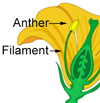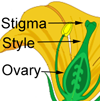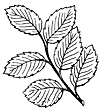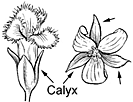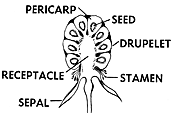Naio
Myoporum sandwicense
Figwort family (Scrophulariaceae)
Native species ()
One of the common trees of the island of Hawaii from sea level to timberline, in both dry and wet forests through the islands. Recognized by its dark gray very thick, rough and irregularly furrowed bark, many crowded narrowly elliptical lance-shaped leaves resinous or sticky when young, small white to pinkish bell-shaped flowers at leaf bases, and whitish oblong rounded

©2005 Forest And Kim Starr
Leaves many, crowded near end of twig, mostly hairless, with flattened yellowish leafstalk of 3⁄8 inch (1 ). Blades 2–6 inches (5–15 ) long and 3⁄8–2 inches (1–5 ) wide, broadest near middle and tapering to long point at both ends, rarely with edges, thin or slightly thickened, side veins not visible, above dull green, paler beneath, with -dots visible under lens.
Flowers many fragrant, 1–9 on slender stalks of 1⁄4–1⁄2 inch (6–13 ), clustered at leaf base and scattered along twig, bell-shaped, about 1⁄2 inch (13 ) across, composed of green of 1⁄8 inch (3 ) deeply 5- pinkish or whitish about 5⁄16 inch (8 ) long with short tube and mostly 5–8 elliptical curved spreading mostly five in notches of and with elliptical mostly five-celled (4–8) with one ovule in each cell and slender
() many on slender stalks at leaf bases and on twigs back of leaves, oblong or rounded, about 5⁄16 inch (8 ) in diameter, whitish or tinged with purple, with and remaining, juicy, bitter, becoming dry, wrinkled, light brown. Stone large, with 5–8 cells and seeds.
Sapwood is pale brown and heartwood dark yellowish brown, moderately heavy ( gr. 0.55), hard, and fine textured. The wood has an attractive figure imparted by dark zones in the growth rings. It gives off an odor somewhat like sandalwood during drying, but the odor is short-lived. After the supply of sandalwood was exhausted, this wood was shipped to China as a substitute, but was not accepted. A fire made from the wood is almost unbearably fragrant, according to Degener (1930, 261–271). Considered a good firewood by most upland ranchers.
Timbers of this species were among those preferred for frames of the Hawaiian houses. It was also used for fishing torches because of its good burning characteristics. A number of large trees have been cut in recent years, and the lumber produced has been used for flooring, furniture, and craftwood items. Although not too stable, it has performed well in service.
This handsome plant with many pinkish white flowers is suitable for cultivation as an ornamental shrub. Livestock poisoning has been reported in related species westward.
Common in dry upland forest and brushlands and near sea level mostly as a shrub. Becoming uncommon in many areas formerly occupied because of site disturbance. On Hawaii and Maui, large trees occur in wet and dry forests, on the other islands it is mostly a shrub. Trees may be seen in Hawaii Volcanoes National Park along the Mauna Loa Strip Road and at Kipuka Puaulu and near Pohakuloa on the Saddle Road. It also grows as a large tree in the Waiakea Forest Reserve ‘ōhi‘a treefern rainforest and in the koa-‘ōhi‘a forest near Kulani Cone. It grows from sea level to timberline at 10,000 ft (3048 ). Recorded from Niihau.
Special areas
Waimea Arboretum, Wahiawa, Bishop Museum, Volcanoes, Kipuka Puaulu
Champion
Height 70 ft (21.3 ), c.b.h. 17.2 ft (5.2 ), spread 56 ft (17.1 ). Keauhou, North Kona, Hawaii (1968).
Range
Including varieties widespread through the Hawaiian Islands including Niihau, but extinct on Kahoolawe. Not known elsewhere.
Other common names
sandalwood myoporum, ‘a‘aka (wood and dead trees), naieo, naeo, false sandalwood.
